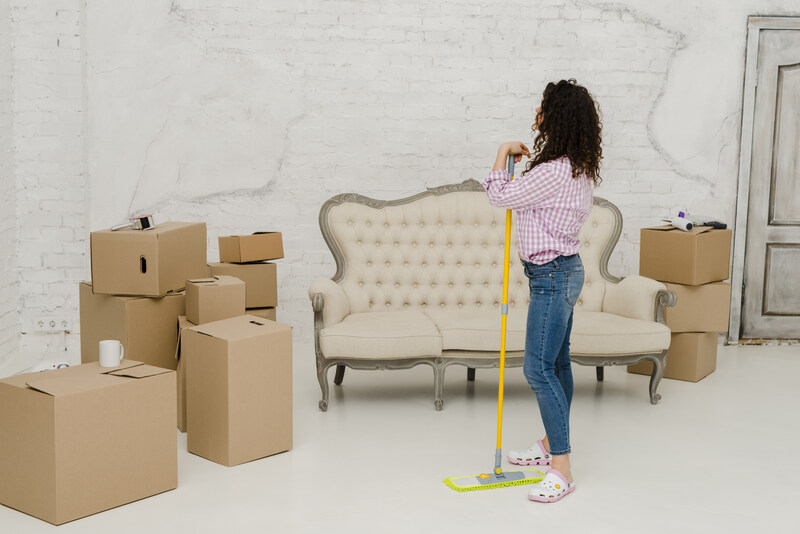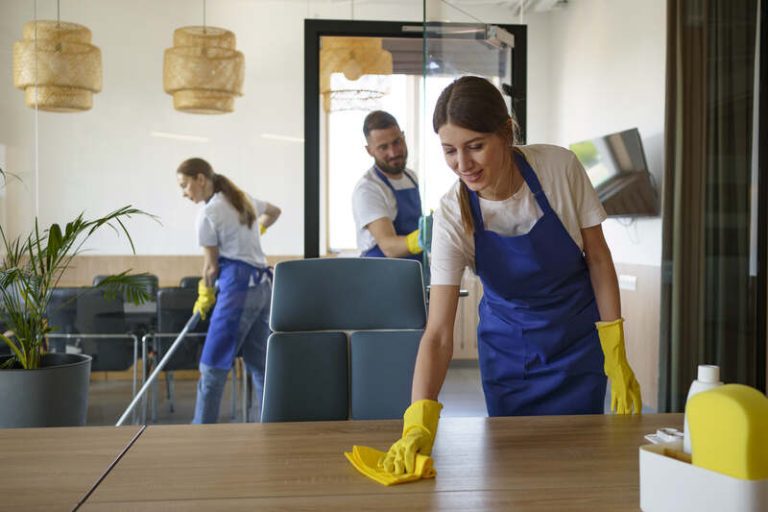Moving out of a rental property can be a stressful time, especially when it comes to ensuring the place is spotless for the next tenants. End-of-tenancy cleaning is a crucial step in this process, but how long does end-of-tenancy cleaning take?
Factors like the size and condition of the property, as well as the type of cleaning required, can all affect the duration of the cleaning process.
In this article, we will learn how long an end-of-tenancy clean takes for different types of properties, as well as the steps involved and some tips to speed up the process. Let’s dive in and make your move a breeze!
What Is End Of Tenancy Cleaning?
Before delving further into how long an end-of-lease clean takes, let’s first start with the definition of end-of-tenancy cleaning itself.
End-of-tenancy cleaning is a thorough cleaning of a property before the tenants move out, ensuring that the property is in top condition for the next occupants or inspection by the landlord. It involves cleaning all areas of the property, from floors to ceilings, and addressing any stains or damages that may affect the return of the security deposit.
By completing a comprehensive end-of-tenancy cleaning, tenants not only uphold their contractual obligations but also leave a positive impression on the landlord, potentially leading to good references for future tenancy. For landlords, ensuring the property is well-maintained through such cleaning not only preserves its value but also minimises the turnover time between tenants, thus maximising rental income.
Common tasks in end-of-tenancy cleaning include scrubbing bathrooms, sanitising kitchens, dusting surfaces, cleaning carpets, and addressing any odours. These tasks not only enhance the aesthetic appeal of the property but also contribute significantly to its hygiene standards.
The Importance of End-of-Tenancy Cleaning
End-of-tenancy cleaning is vital for both tenants and landlords as it ensures that the property is left in a clean, presentable state. For tenants, it helps in getting their full security deposit back, while for landlords, it ensures that the property is ready for the next occupants without any cleaning issues.
This type of cleaning involves a thorough top-to-bottom cleaning of the entire property, including walls, floors, appliances, windows, and more. The main goal is to return the property to the same condition it was in at the beginning of the tenancy. Landlords usually expect the property to be professionally cleaned, sometimes even requesting proof of cleaning receipt. This practice not only benefits landlords in maintaining the property’s value but also helps tenants secure a refund of their security deposit.
Factors Affect End of Tenancy Cleaning Time
Basically, there is no definitive answer to the question end-of-tenancy cleaning and how long. This is because several factors can influence the time needed for end-of-tenancy cleaning, including the size and condition of the property, the number of rooms that require cleaning, the specific cleaning tasks outlined in the rental agreement or checklist, and the location.
For instance, a larger property with multiple bedrooms, bathrooms, and living areas will naturally require more time compared to a smaller flat. The condition of the property, whether it has been well-maintained or needs deep cleaning, significantly impacts the duration of the cleaning process.
The specific cleaning tasks specified in the rental agreement or checklist play a crucial role. Tasks like carpet cleaning, window cleaning, and oven degreasing can add considerable time to the overall cleaning timeframe.
Location-specific requirements, such as those in bustling cities like London with high cleanliness standards, may necessitate more meticulous cleaning procedures, further extending the duration of the end-of-tenancy cleaning.
a. Size Of The Property
The size of the property is a significant factor in determining the duration of end-of-tenancy cleaning. Larger properties with more rooms and living spaces generally require more time and effort to clean thoroughly.
One of the challenges of cleaning a larger property is the sheer magnitude of the task. With multiple bedrooms, bathrooms, kitchens, and living areas, each requiring individual attention, the cleaning process can be quite time-consuming. In addition, larger properties often have extensive floor areas that need to be vacuumed, mopped, or carpet cleaned, adding to the overall cleaning duration. Ensuring all corners, nooks, and crannies are cleaned effectively in a large property demands meticulous attention to detail, which further extends the cleaning time.
b. Condition Of The Property
The initial condition of the property plays a crucial role in determining the duration of end-of-tenancy cleaning. Properties with deep stains, damage, or neglect may require more intensive cleaning tasks and the involvement of professional cleaning staff.
Deep-seated stains or extensive damage can be challenging to remove, often necessitating specialised cleaning techniques. Professional intervention may be needed to tackle mould growth, stubborn grime, or other persistent issues. Neglected properties may harbour hidden dirt and odour that regular cleaning may not suffice to eliminate. Areas like carpets, upholstery, and walls may require deep cleaning processes involving steaming, extraction, or chemical treatments to restore them to a satisfactory condition.
c. Number Of Rooms
The number of rooms in a property directly impacts the duration of end-of-tenancy cleaning. Each room, including bedrooms, bathrooms, and living areas, requires specific cleaning tasks and attention to detail.
For example, bedrooms usually involve tasks such as changing bed linens, dusting furniture, and vacuuming carpets, which can be time-consuming depending on the room’s size and clutter.
Bathrooms demand thorough cleaning of tiles, sinks, toilets, and showers, often requiring the use of specialised cleaning agents.
Living areas necessitate cleaning upholstery, dusting electronic devices, and mopping floors.
With each additional room comes a new set of cleaning tasks that need to be completed efficiently. The more rooms there are, the longer it typically takes to ensure that each space is thoroughly cleaned to meet the end-of-tenancy standards.
d. Type Of Cleaning Required
The type of cleaning required for end-of-tenancy cleaning can significantly impact the time needed. Properties that need specialised cleaning services, professional cleaners, or specific cleaning products may take longer to complete the cleaning process.
Professional cleaners are trained and equipped to handle intricate cleaning tasks efficiently, which can reduce the overall time spent on cleaning. Their expertise allows them to tackle challenging areas effectively, ensuring a comprehensive cleaning job.
- Specialised cleaning services cater to unique cleaning requirements, such as deep cleaning carpets, removing stubborn stains, or sanitising specific areas. These specialised tasks often demand more time and attention to detail, extending the cleaning process.
- Using appropriate cleaning products is crucial for achieving effective results within a reasonable timeframe. The right products can expedite the cleaning process by efficiently breaking down dirt and grime, leading to a quicker and more thorough cleaning.
How Long Does End of Tenancy Cleaning Take Usually?
As mentioned earlier, the question of how long an end-of-tenancy cleaning takes does not have a definitive answer. This happens because the duration of end-of-tenancy cleaning can vary based on the size of the property and the extent of cleaning required.
Whilst smaller properties like a studio or one-bedroom flats may take a few hours, larger properties with multiple rooms could require a day or more to complete the cleaning process.
For studio flats, the cleaning process usually ranges from 2 to 4 hours, depending on the condition. One-bedroom properties typically require around 3 to 5 hours for a thorough cleaning.
Moving up to two-bedroom flats, the cleaning time can extend to 4 to 7 hours for comprehensive cleaning of additional spaces. When dealing with larger properties such as three-bedroom houses or more, the cleaning process becomes more intricate, requiring a minimum of 8 to 12 hours for a complete top-to-bottom cleaning, including all rooms, bathrooms, and living spaces.
To get an idea of the answer to how long does end of tenancy cleaning takes, here is a further explanation.
a. Studio/One-Bedroom Apartment
A studio or one-bedroom flat typically takes a few hours to complete end-of-tenancy cleaning. With a smaller living space and fewer rooms, the cleaning process can be efficiently managed by a dedicated cleaning staff.
Starting with decluttering and organising the space can pave the way for a smoother cleaning operation. Using multipurpose cleaners can be a time-saving trick, reducing the number of products needed.
Focusing on high-traffic areas and frequently touched surfaces ensures thorough cleaning without unnecessary repetition.
b. Two-Bedroom Apartment
A two-bedroom flat may require half a day or more for end-of-tenancy cleaning. The additional room and living space compared to a studio or one-bedroom flat contribute to the extended cleaning time and the need for appropriate cleaning products.
When cleaning a two-bedroom flat, one must consider the additional surfaces, such as extra windows, more extensive flooring, and multiple bathrooms that require thorough attention. Properly dusting, vacuuming, and sanitising two separate bedrooms, along with the common areas like the living room and kitchen, demands time and effort.
Choosing the right cleaning products becomes crucial in ensuring the effectiveness of the cleaning process. Multi-surface cleaners, disinfectants, and stain removers are essential for addressing various cleaning needs in different rooms.
c. Three-Bedroom Apartment
Cleaning a three-bedroom flat as part of end-of-tenancy cleaning may take a full day. The increased number of rooms and potential cleaning tasks in larger flats require thorough attention to detail and careful planning.
One of the key strategies for efficiently cleaning a three-bedroom flat is to start by decluttering and organising each room. This helps in creating a clear space for the actual cleaning process.
Task prioritisation is crucial in managing your time effectively; you can prioritise tasks based on their urgency or the time they may consume.
Creating a cleaning schedule or checklist can be immensely helpful in ensuring that no area is overlooked or rushed through. Remember, a methodical approach is key to tackling the time-intensive endeavour of cleaning multiple rooms.
d. Larger Properties
For larger properties such as houses or commercial spaces, end-of-tenancy cleaning can span multiple days. The extensive cleaning requirements and the need for professional cleaning services contribute to the longer duration of the cleaning process.
One of the primary challenges in cleaning larger properties during the end of a tenancy is managing the diverse cleaning needs of different areas. Each room presents unique cleaning requirements, from deep cleaning carpets in the living room to sanitising bathrooms and kitchens. Efficiently addressing all these tasks demands careful planning and organisation.
The Steps Involved In End Of Tenancy Cleaning
End-of-tenancy cleaning typically involves a series of steps to ensure a thorough cleaning process. These steps include dusting and hoovering, cleaning and disinfecting bathrooms, tackling kitchen appliances and surfaces, wiping down walls and skirting boards, and cleaning windows and mirrors.
In terms of dusting and hoovering, attention to detail is key. Make sure to reach all corners and crevices to eliminate dust and debris that may have accumulated over time. For bathroom cleaning, it’s crucial to focus on removing soap scum, mould, and mildew to ensure a hygienic environment. Addressing kitchen appliances not only enhances their longevity but also prevents any potential odours or bacteria buildup.
Wiping down walls and skirting boards may seem like a minor task, but it significantly contributes to the overall cleanliness of the property. Cleaning windows and mirrors add a finishing touch, allowing natural light to brighten up the space and giving a polished look to the interior.
a. Dusting And Vacuuming
Dusting and hoovering are crucial initial steps in end-of-tenancy cleaning to remove dust, dirt, and debris from various surfaces. These tasks help prepare the property for more detailed cleaning and disinfection processes.
When dusting, it’s essential to work from top to bottom, starting with higher surfaces like shelves and countertops before moving down to tables and finally the floor. Using a microfibre cloth can help trap dust particles effectively without spreading them around. For hoovering, choose the right attachments for different surfaces such as upholstery, hardwood floors, or carpets. Consider using a HEPA filter hoover to capture even the smallest dust particles and allergens, ensuring a thorough clean.
b. Cleaning And Disinfecting Bathrooms
Cleaning and disinfecting bathrooms is a critical step in end-of-tenancy cleaning to ensure hygiene and sanitation. Removing stains, mould, and grime from bathroom surfaces and fixtures is essential for a clean and fresh appearance.
In terms of tackling stubborn stains in the bathroom, it’s important to use the right cleaning products and tools. For instance, a mixture of vinegar and bicarbonate of soda can work wonders in breaking down tough grime and mineral deposits. Scrubbing vigorously with a brush or sponge can help lift off dirt from tiles and grout.
Addressing mould growth is a common challenge in bathrooms due to the high humidity levels. To combat mould effectively, use a bleach solution or a specialised mould remover. Ensuring proper ventilation in the bathroom can also help prevent mould from returning.
c. Cleaning Kitchen Appliances And Surfaces
Cleaning kitchen appliances and surfaces is a key aspect of end-of-tenancy cleaning, as the kitchen often accumulates grease, food residues, and stains. Thoroughly cleaning countertops, cabinets, and appliances ensures a hygienic kitchen environment.
When tackling stubborn stains on kitchen surfaces, a mixture of bicarbonate soda and water can be a great natural cleaning solution. Applying this paste gently and allowing it to sit before scrubbing can effectively remove the toughest stains. For grease buildup, a mixture of vinegar and water sprayed on the surface can help break down the grease for easier removal. It’s essential to pay attention to details like the extractor hood, cooker, and fridge interiors during the cleaning process to ensure a thorough job.
d. Wiping Down Walls And Baseboards
Wiping down walls and skirting boards is an essential step in end-of-tenancy cleaning to remove dust, marks, and stains. Cleaning these surfaces enhances the overall appearance of the property and ensures a fresh and well-maintained look.
One of the best ways to start is by dusting the walls and skirting boards with a dry microfibre cloth to remove any loose dirt and debris. For tougher stains, a mixture of water and mild soap can be effective, but remember to test it in an inconspicuous area first. Different stains like crayon marks or scuff marks may require specific cleaning methods, such as using baking soda paste or a magic eraser for more stubborn spots.
e. Cleaning Windows And Mirrors
Cleaning windows and mirrors is a final touch in end-of-tenancy cleaning to add sparkle and shine to the property. Removing streaks, smudges, and dirt from windows and mirrors enhances natural light and visual appeal.
To achieve streak-free results, start by dusting or vacuuming the surface to remove loose dirt and debris. Next, prepare a solution of vinegar and water, or opt for a commercial glass cleaner, and apply it with a microfibre cloth or squeegee. Use vertical strokes on windows and horizontal strokes on mirrors for easier streak identification. Consider finishing with a dry microfibre cloth or newspaper to polish the glass for enhanced transparency and cleanliness.
Some Tips To Speed Up The End Of Tenancy Cleaning Process
To expedite the end-of-tenancy cleaning process, consider decluttering beforehand, ensuring you have the right cleaning supplies, dividing tasks efficiently, and if necessary, hiring professional cleaners to handle specific cleaning requirements.
One effective strategy to streamline the cleaning process is to start by sorting through each room and getting rid of unnecessary items. This not only reduces the amount of clutter to clean around but also makes the actual cleaning much easier and faster.
Creating a cleaning checklist can help you stay organised and ensure that no area is overlooked. Break down the tasks into smaller, manageable chunks and tackle them one by one to prevent feeling overwhelmed.
When selecting your cleaning supplies, opt for products that are appropriate for the different surfaces in your home. Investing in quality tools and chemicals can make a significant difference in the end results.
a. Declutter Beforehand
Decluttering the property before starting end-of-tenancy cleaning can streamline the process by removing unnecessary items and creating a more organised space for cleaning tasks. It also helps in identifying areas that require special attention.
By sorting items into categories like keep, donate, or discard, tenants can efficiently declutter the space, making it easier to clean and pack later. Once the unwanted belongings are identified, disposing of them responsibly through donation, recycling, or proper disposal methods not only reduces clutter but also benefits the environment. Creating a clear cleaning plan based on the property’s condition ensures that each area is thoroughly cleaned, saving time and effort during the actual cleaning process.
b. Have The Right Cleaning Supplies
Having the right cleaning supplies, including multi-surface cleaners, disinfectants, microfibre cloths, and sponges, is essential for efficient and effective end-of-tenancy cleaning. Using the appropriate products can simplify cleaning tasks and achieve better results.
For specific surfaces like hardwood floors, it’s crucial to use wood floor cleaners or polishes to maintain their finish and shine without causing damage. Glass surfaces require glass cleaners to avoid streaks and spots. For stubborn stains, having a good stain remover can work wonders. Invest in a high-quality vacuum cleaner to reach hidden dirt, and a scrubbing brush for deeper cleaning. Don’t forget gloves to protect your hands while handling chemicals.
c. Divide And Conquer
Dividing cleaning tasks among individuals or teams can expedite the end-of-tenancy cleaning process. By assigning specific responsibilities and areas to different cleaners, you can efficiently tackle multiple tasks simultaneously and complete the cleaning more quickly.
A key aspect of dividing tasks is ensuring proper coordination between team members to avoid duplication of efforts and ensure comprehensive cleaning coverage. Establishing a clear cleaning plan listing tasks, timelines, and responsible individuals can enhance organisation and productivity. Optimising workflow by starting with common areas and gradually moving to more personal spaces can help maintain momentum and efficiency. Remember to provide necessary cleaning supplies, schedule regular check-ins, and offer support to ensure a smooth and successful end-of-tenancy cleaning process.
d. Hire Professional Cleaners
Engaging professional cleaners for end-of-tenancy cleaning can save time and ensure a thorough and high-quality cleaning outcome. Professional cleaners have the expertise, tools, and experience to address specific cleaning requirements efficiently.
Professional cleaners are well-versed in handling a variety of cleaning tasks, from deep cleaning carpets to sanitising kitchens and bathrooms. They are equipped with specialised tools and cleaning agents that are often not readily available to the average homeowner.
By hiring experts in end-of-tenancy cleaning, you can rest assured that your rental property will meet the high cleaning standards expected by landlords, ensuring the safe return of your security deposit. This not only saves you time and effort but also provides peace of mind knowing that the job will be done to a professional standard.
So that’s the full explanation about how long an end-of-tenancy cleaning takes, highlighting its importance and detailing the process involved. But understanding it is just the start. Now, let TEKA Cleaning take care of it for you. Our professional end-of-tenancy cleaning services ensure a stress-free move-out process, leaving your property immaculate and ready for its next occupants.
Why worry about the meticulous cleaning process when you can leave it to the experts? Our team guarantees a thorough clean, and if your landlord isn’t satisfied, we’ll return to ensure they are. Plus, if you’re a landlord or agency, we also offer pre-tenancy cleaning to prepare your property for new occupants.
Make your move stress-free with TEKA Cleaning. Book our professional end-of-tenancy cleaning services now or give us a call at 01233 751 544. Let us handle the cleaning while you focus on your next adventure.
Read also:










